PROJECT
The Ritual Scenarios of Migration in the Context of Southern Italy
This project investigates the ritual scenarios of migration in urban contexts of Southern Italy or those that stem from such contexts, to understand if and how the processes of ritualization triggered by migration produce embodied forms of sociality. To what extent do ritual practices contribute to defining a better integration between host groups and migrant groups? In what scenarios do socio-political polarization and identity-rooting situations emerge? Through field research and anthropologically oriented comparison, the goal is to understand within which historical contingencies, which configurations of public space, which social policies, and which moral economies the rituals of migration take shape. Public spaces shaped by “traditional” forms of collective religious rituality will therefore be investigated, as these constitute the ceremonial environment in relation to which more established migrant groups try to shape some form of “presence”; ritualization processes that emerge in response to the migrant condition or even directly express this migrant presence; forms of institutional ritualization enacted by the “emergency” structures of “reception.”
The study of the connections between religion and migration is a well-established field in socio-anthropological research. However, the focus has mainly been on analysing the public dimensions of religious belonging in the migratory space, while the more intimate, embodied dimensions of ritualistic and devotional practices in migration have been largely neglected. Positioned in ethnographic contexts such as Sicily and Basilicata, where popular religiosity and devotional practices have a long tradition of a contested relationship with the nation-state and religious institutions, the project aims to understand how the rituals emerging in migration help shape the lines of social subalternity and individual and public agency in Southern Italy, and also how the forms of ceremonial contest/conflict involving migrants influence the political-religious sphere in the contexts being studied.
FOUR RESEARCH UNITS
MESSINA, PALERMO, CATANIA MATERA
The project consists of four research units—Messina, Palermo, and Catania in Sicily, and Matera in Basilicata—that will explore migration rituals in three main directions:
- Public spaces heavily shaped or saturated by manifestations of collective religious rituals (often embedded within national and global contemporary contexts), which form ceremonial environments where migrant groups with a longer settlement history attempt to assert some form of “presence.” These spaces also often serve as arenas for ceremonial contention over control of the socio-political-religious sphere in the contexts under investigation.
- Emergent ritualization phenomena/processes that arise in response to the specific migrant condition or are directly and immediately expressive of the migrants’ presence, without any evident connection to the local “ritual ecology.”
- Institutional forms of ritualization enacted by “emergency” and “liminal” structures of so-called reception processes to manage the arrival of masses of women, children, and men fleeing to ports, various centers, and communities in Sicily and Southern Italy.
Intensive field studies across diverse contexts and scales will allow for varying interpretations of the migration/ritual nexus, producing a cross-cultural comparison that has not yet been systematically attempted in southern Italy. To address this intellectual challenge, in addition to essential ethnographic research, the project will integrate interdisciplinary expertise (combining anthropology with historiographical, geographical, sociological, and linguistic perspectives) and experimental “elicitation techniques” applied to 3.0 audiovisual materials.
The originality of the proposed method will be expressed through a dataset of photographic, visual, and sound artifacts that facilitate access to the sensory and bodily experience of the ritual spaces and times examined. Applied to realities such as those of southern Italy—shaped by ritual and ceremonial dynamics with strong jurisdictional implications—this combined focus on the migration/ritual nexus, conveyed through these elicitation tools, can serve as an effective antidote to the media/ideological trivialization of migrant presence and the increasingly marked development of xenophobia and (neo)racism.
The curated sensory and multimedia catalogue will be hosted on the project’s website and showcased in a traveling exhibition.
Messina
The Messina unit focuses on three main areas of interest. First, in close connection with some of the objectives identified by other units, it aims to observe and analyze, using ethnographic methodology, the rituals of migrant agricultural laborer communities, which have a significant and longstanding presence in Sicily’s agricultural context. It will investigate the presence—or reasons for the potential absence—of migrant individuals or communities within the traditional public religious ceremonies of Naples. Finally, the unit will examine spaces and places of immediate migrant reception as territories for applying institutional rituality. This involves considering the re-utilization of practices associated with the immediate “welcoming” of newly arrived migrants as a specific tool for constructing liminal spaces distinct from those of urban daily life.
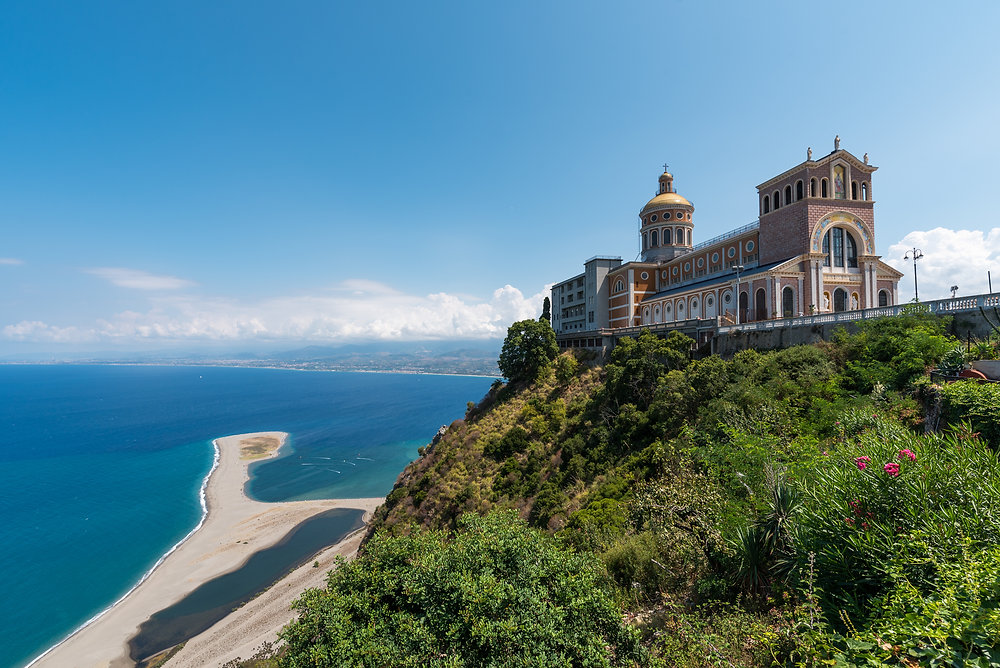
Il Santuario della Madonna nera di Tindari
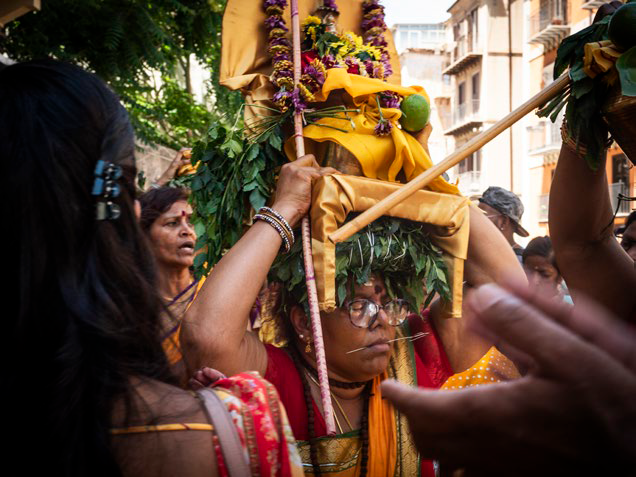
Decimo giorno di Canjee Poosai
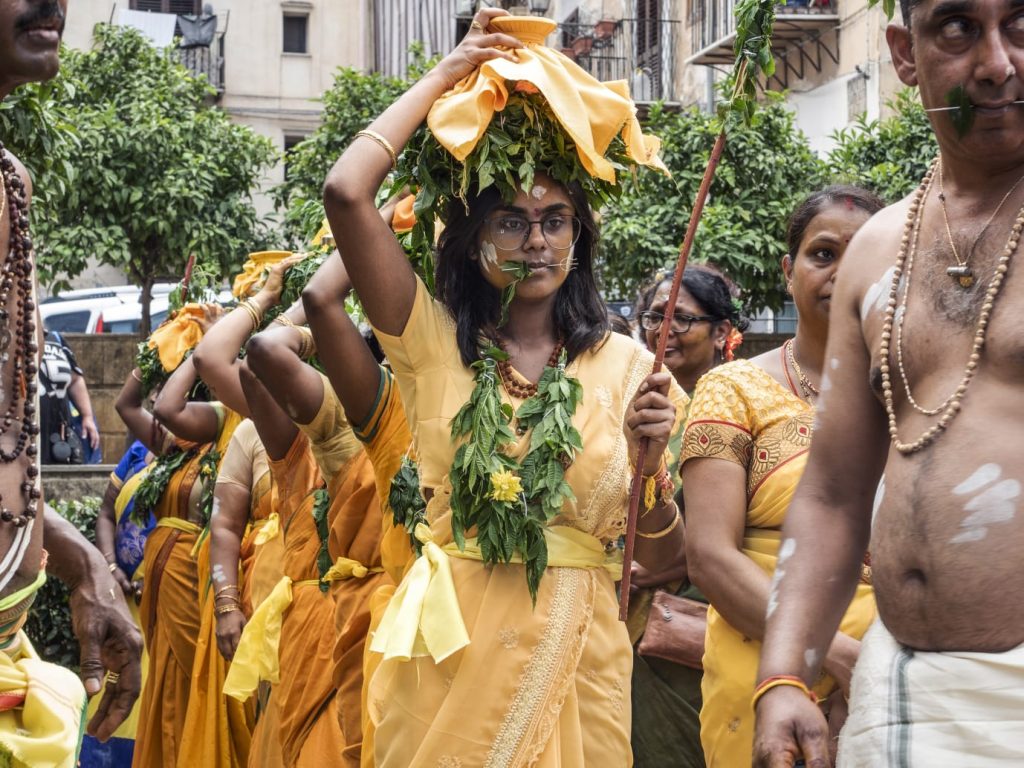
Palermo, festa di Canjee Poosai.
Palermo
The Palermo Unit centers its research on the spatiotemporal dimensions of religious practices with which certain migrant communities, long settled in the city, interweave within Palermo’s urban fabric and temporal rhythms. Specifically, the ethnographic study will focus on Tamil and Mauritian Hindu communities and Tamil Catholic communities. These groups share worship spaces (regarding economic management and maintenance) but celebrate ceremonies separately, with ethnic composition prevailing among devotees. However, migrant communities are present in the public space during the pilgrimage to the Sanctuary of Santa Rosalia, on both September 4, the canonical pilgrimage date, and during individual ascents to the Mount on Sunday mornings, alongside native Palermitans. Tamil Catholics also participate in these devotions but maintain a separate space for regular worship, with their own dedicated church and Tamil-speaking officiant. More generally, the research will investigate where in the city worship takes place, what these spaces reveal about urban residence, the rhythms of worship, and how these rhythms integrate into the migrants’ daily lives. Festive calendars, modes of interaction in worship spaces, and relationships with local religious ceremonies will also be reconstructed.
Catania
The Catania research unit focuses on two main areas. The first is the Sri Lankan community, predominantly Catholic but also Hindu and Buddhist, in Catania. It examines their presence and role in the patronal feast of Saint Agatha and the pilgrimage to the Madonna of Tindari, considering opportunities for interprovincial comparisons.
A key objective is the ethnographic understanding of “home-making” practices by Sri Lankan migrants through the domestication of devotions linked to female Catholic figures. The unit also explores transnational connections between Sicily and Sri Lanka, evident in the itineraries of Saint Agatha’s relics, linking Catania to the communities’ countries of origin—a circularity observed in other Marian devotions, such as that of the Madonna of Tindari.
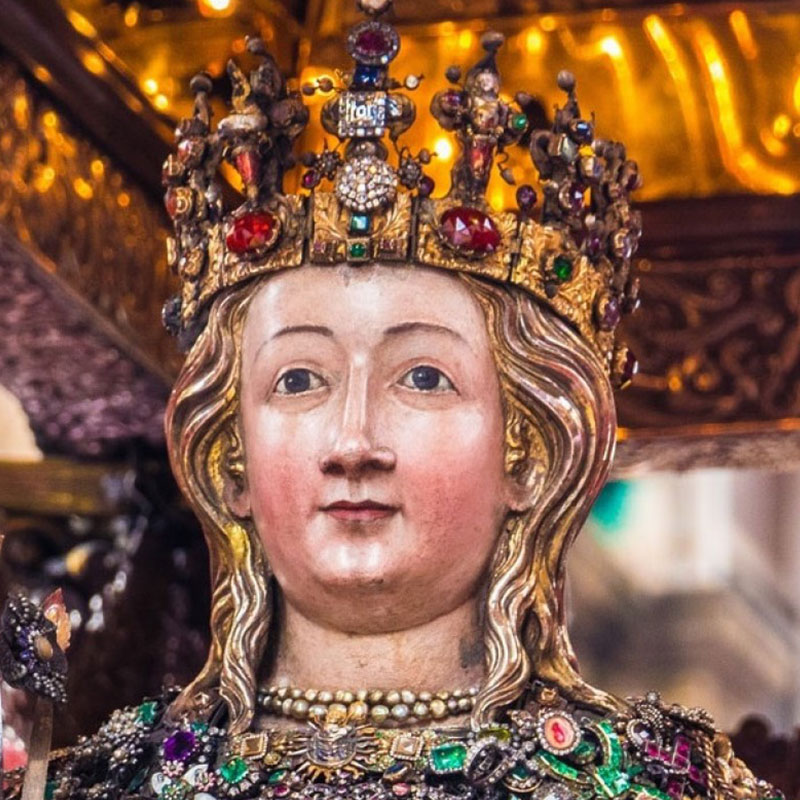
Il busto reliquiario di sant'Agata
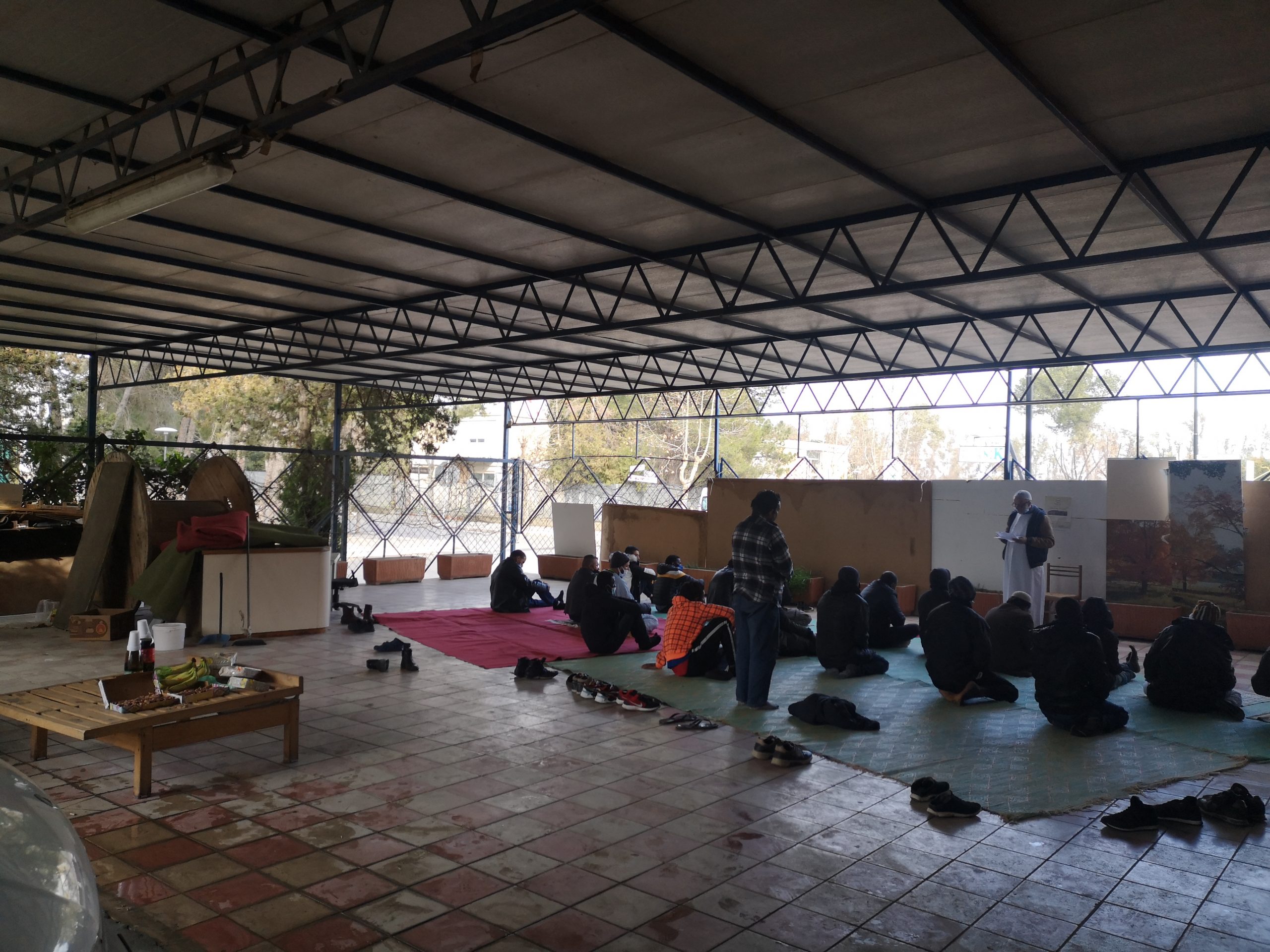
Metapontino, preghiera in un capannone.
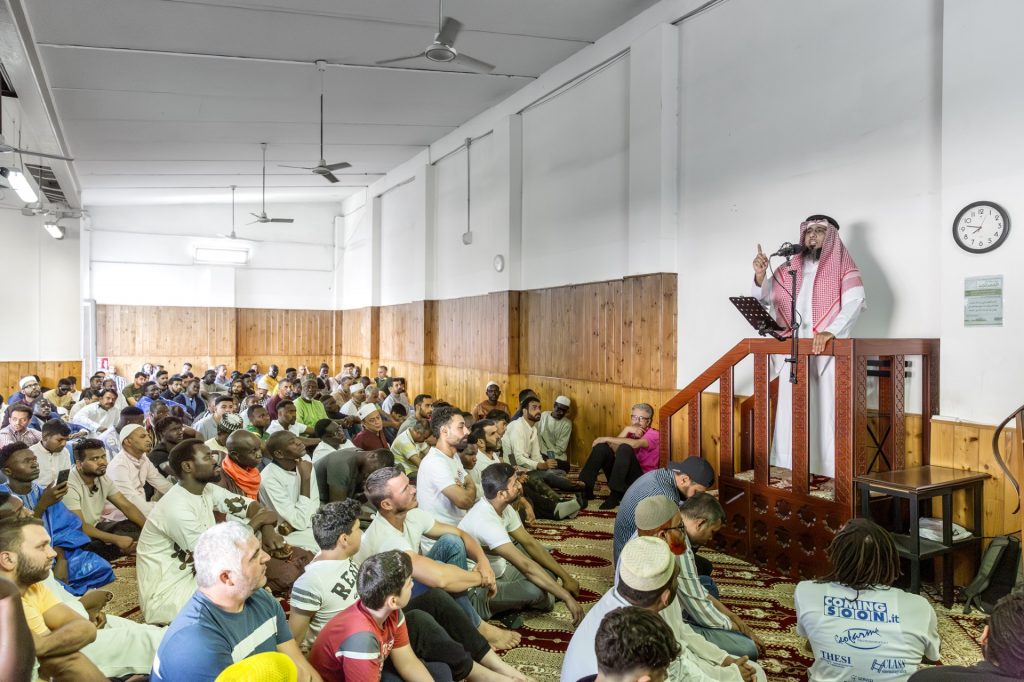
Bari, preghiera in una moschea.
Matera
The Basilicata region, which has seen an increasing presence of migrants in recent years, serves as the second geographical area of focus alongside the city of Bari in Apulia. The Matera research unit investigates specific ritual practices to explore diverse forms of rooting, uprooting, and connection with host communities.
The research follows two primary lines: 1. Migrants and Islamic rituals in Bari; 2. Migrants and everyday rituals (both public and private) in the Metapontino area.
The study aims to document home-making practices occurring in religious contexts, such as Islamic prayer times, as well as place-making dynamics. It also investigates secular rituals, such as everyday behaviors in migrants’ living, working, and social spaces.
As part of the broader project framework, the Matera unit will also contribute to the planning and development of an exhibition on the explored themes, leveraging its internal museographic expertise.
